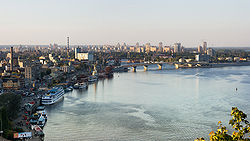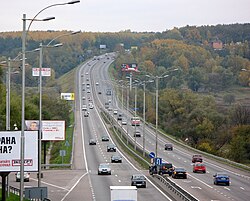
Kyiv, the capital of Ukraine, has an extensive and rapidly developing transportation infrastructure serving local public needs and facilitating external passenger and cargo traffic.

Kyiv, the capital of Ukraine, has an extensive and rapidly developing transportation infrastructure serving local public needs and facilitating external passenger and cargo traffic.
Public transportation includes metro, bus, trolleybus, and tram lines, as well as a funicular. All public transport is operated by Kyivpastrans, besides the metro.[ citation needed ] The city's first references to public transportation date back to the 1880s, when the city introduced omnibuses and was looking for investment in horse-drawn trams.[ citation needed ] The Kyiv Urban Electric Train is a joint project of Kyivpastrans and Ukrzaliznytsia.[ citation needed ] Kyivpastrans rarely operate minibuses.
The publicly owned and operated Kyiv Metro is a fast, convenient and affordable network covering most of the city. The metro is expanding towards the city limits to meet growing demand.

The Kyiv Metro is the city’s primary mode of intracity transportation. It was the first rapid transit system in Ukraine. The system has three lines, with a total length of 66.1 kilometres (41.1 miles), and 51 stations.[ citation needed ]
The metro carries an average of 1.422 million passengers daily, [1] 38 percent of Kyiv's public transport.
In 2011, the total number of trips exceeded 519 million. The metro is also home to the deepest station in the world: Arsenalna, at 105.5 m or 346 ft in the ground. [2]

The Kyiv Tram, the oldest in Eastern Europe,[ citation needed ] was for a long time being replaced by buses and trolleybuses, however, the trend is partially being reversed with the redevelopment of the Kyiv Fast Tram as well as planned investments in the classic tram network.[ citation needed ]
The Kyiv Trolleybus is the largest of its kind in the world in terms of line length[ citation needed ] and has many routes spanning the entire city.
One of the most popular and useful routes for tourists is bus No 24 (24A on weekends and holidays), travelling through Kyiv Passenger Railway Terminal, Khreshchatyk, European Square and the Kyiv Pechersk Lavra.

In 2010, Kyiv Urban Electric Train service began, running at four to ten minute intervals throughout the day around the city centre and serving many of Kyiv's inner suburbs. There are many stops with transfers to the Kyiv Metro. [3]
In 2019, the city train operated only in rush hours from 07:00–10:00 and 16:00–20:00. Trains were very often cancelled or delayed. As a rule every day more than 40% of the rides were cancelled.[ citation needed ]
Passengers can get from Zhuliany Airport by trolleybus No 9 to Kyiv Passenger Railway Terminal and Palace of Sports, near the centre of the city. Passengers can get from Boryspil Airport by the Kyiv Boryspil Express. One ride costs ₴80. Tickets are available in ticket machines in the airport and from a train conductor.

There are no timed tickets for public transport in Kyiv. Each ride should be paid for in each bus, trolleybus, tram, or metro. Passengers can pay for their ride by tapping Apple / Google Pay phone, Kyiv Tsyfrovyi app, Kyiv Tsyfrovyi plastic card or a paper ticket with a QR code. One can buy tickets on the internet and just validate them from a smartphone screen or buy them in a ticket machine, located at metro stations or some vendors.
In buses, trams and trolleybuses operated by Kyivpastrans, one ride costs ₴8. [4] These prices are the same in the metro.
1 ride costs ₴8 (by ticket or Kyivsmartcard)
10 rides cost ₴7.70 (by Kyivsmartcard)
50 rides cost ₴6.50 (by Kyivsmartcard)
The penalty for travelling without a ticket is ₴160.
One Kyivsmartcard costs ₴50 and should be activated before use.

The previously extensive Kyiv River Port riverboat service along the Dnieper River with the Meteor and Raketa hydrofoil ships is no longer available, limiting Kyiv's river transport to cargo and tour boats and private pleasure craft.
Kyiv is a crossing point for many of Ukraine's main roads. The focal point of the Ukrainian national-road system, Kyiv is linked by road to many of Ukraine's principal cities. The M05 (linking Kyiv with Odesa) and the M06 (linking the city with Chop) have been reconstructed.

Without a grade-separated ring road, Kyiv has two urban bypass routes. The Central Ring (Small Bypass Road) comprises a number of interconnecting, high-capacity roads encircling the city centre, with a full circular route on both banks of the Dnieper, and is congested at rush hour. The Big Bypass Road has no river crossings, and is confined to the city's right bank. Despite this, it reduces traffic in the city centre.
Many Kyiv roads are in bad condition, and maintenance is poor. According to Kyivavtodor (the municipal road corporation), 80 percent of the city's road surfaces have been in use for 15 to 30 years, 1.5 to 3 times more than the standard 12-year lifespan. [5]

The taxi market in Kyiv is poorly regulated (in particular, the fare per kilometer) and there is brisk competition among private companies. Many allow the scheduling of a pickup by telephone. Private citizens with cars provide taxi service on an ad hoc basis, generally by picking up people hailing a cab. Traffic congestion and a lack of parking space are problems for Kyiv taxis. Regulations allow parking on sidewalks, which inconveniences pedestrians.
The funicular climbs the Dnieper's right bank, carrying 10,000–15,000 passengers daily. The city has a long-distance passenger station, six cargo stations and repair facilities.
Air passengers arrive in Kyiv at one of two airports: Boryspil Airport (served by international airlines) or Zhuliany Airport.
Some of the airlines operating in Boryspil (KBP) are Ukrainian, Ryanair, Austrian, Air France, KLM, Skyup, Qatar, Pegasus, British Airways, Turkish airlines, Air Baltic, etc.
Companies operating in Zhuliany airport (IEV) are WIZZ Air, Vueling, Ernest, Motor Sich, LOT, Alitalia, Belavia, etc.
Hostomel Airport is in the Kyiv northwestern suburb of Hostomel, and primarily serves as a cargo airport.